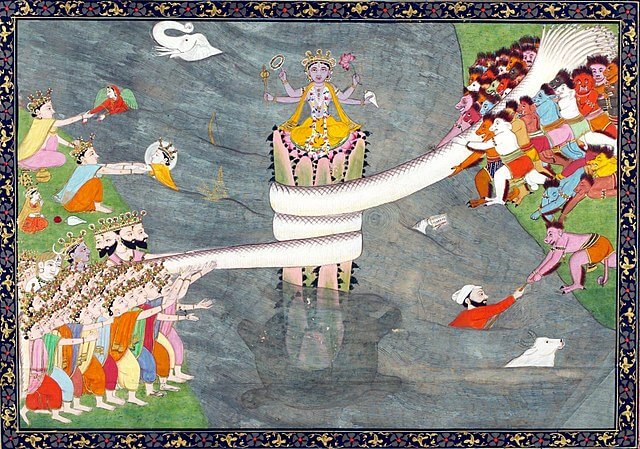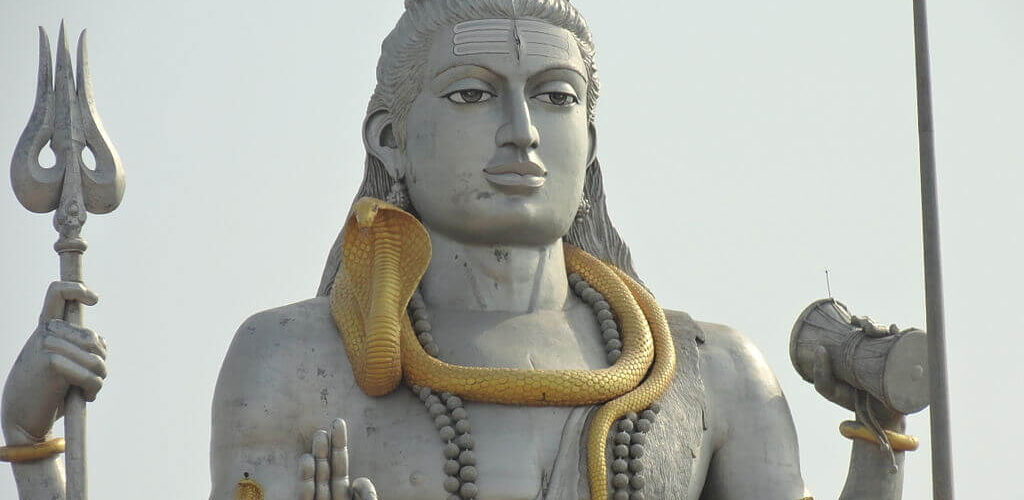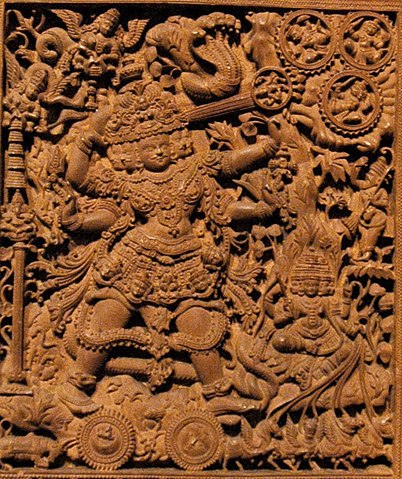In Hindu mythology, snakes are often depicted as powerful and divine creatures with great spiritual significance. One of the most prominent snake deities in the Hindu religion is Vasuki, a powerful cobra and the king of the sarpas (serpents). Vasuki is one of the sons of the sage Kashyapa and his consort Kadru. Vasuki’s elder brother is Shesha, the eternal snake, upon which Lord Vishnu rests. According to the Hindu epic Mahabharata, Vasuki lives in the palace of Varuna, the god of the sea.
Featured Image: Foliate08, Shiva 01, CC BY-SA 3.0
You may also like:
Samudra Manthan: One of the Most Beautiful Stories in Hindu Mythology
Lord Shiva: The Powerful Destroyer of the World
Vishnu: The Powerful Protector of the World
Table of Contents
- The Story of Lord Shiva and Vasuki
- Vasuki as a Symbol of Spiritual Enlightenment
- The Worship of Vasuki
- Conclusion & Final Thoughts
The Story of Lord Shiva and Vasuki
The serpent king is closely associated with Lord Shiva. He is often depicted coiled three times around the neck of Lord Shiva as an ornament. The three coils symbolize the past, present and the future. Vasuki plays a significant role in several Hindu legends and is worshipped by many as a symbol of spiritual enlightenment and divine power. He represents Kundalini, the primal energy that lies at the base of the spine and is said to be the source of spiritual awakening.
Moreover, Vasuki is also related with the Pasupathinath (lord of all creatures) aspect of Lord Shiva, and his worship is seen as an important aspect of Hindu spirituality. According to legend, once the snake species was in peril and approached Lord Shiva for help, who gave them shelter in his abode, in mount Kailash. However, due to the very low temperatures of Kailash, the snakes would seek warmth close to the body of Shiva.
There are numerous stories associated with Vasuki in the Puranas, however, the two most well known ones are the Samudra Manthan and the Tripura Dahana. Moreover, in the Hindu epic Mahabharata, there is an account of how Vasuki brought the Pandava prince Bhima back to life.
Samudra Manthan (The Churning of the Milky Ocean)

According to the Puranas, Vasuki played a significant role in the Samudra Manthan, also known as the story of “The Churning of the milky ocean”, where he served as the rope to churn the ocean of milk. His role in the Samudra Manthan made him a legendary figure in Hindu mythology, and he is often depicted as a symbol of power and resilience.
In another variation of the legend, Vasuki is said to have consumed the Halahala, the deadly poison that emerged during the churning of the ocean. Impressed by his sacrifice, Shiva blessed him and decided to wear Vasuki around his neck as a symbol of divine power.
Tripura Dahana (The Destruction of Tripura)
According to Hindu scriptures, Vasuki also played a crucial role in the destruction of Tripura, a fortress of the Asuras (demons). The three Asura brothers Tarakaksha, Vidyunmali and Kamalaksha, had managed to get a boon from Lord Brahma. They asked for three forts to be made, one in the heaven, one in the sky and one on earth.
The first fort made of gold was built in heaven, the second of silver was built in the sky and the third of iron was built on earth. These forts would align and merge into one every 1,000 years. This combined fort, called Tripura (meaning three forts), could only be destroyed with only a single arrow that would pierce its walls.
Lord Brahma granted the boon but soon after, the demons became evil and started acting against the religion of the Vedas. The gods asked Shiva to destroy Tripura, so he mounted his chariot, took his bow and arrow and headed for Tripura. But, when he arrived there he saw that the string of his bow was missing. That’s when Vasuki, the powerful snake, offered to become his bowstring. Lord Shiva gratefully accepted Vasuki’s offer. Right at the moment the three cities began to merge into one, Shiva shot his arrow, the divine Pashupatastra, burning Tripura to ashes and killing the demons.
This tale is often interpreted as a symbol of the powerful bond between Lord Shiva and Vasuki, and highlights the importance of devotion and sacrifice in Hindu mythology. Vasuki’s act of becoming the string for Shiva’s bow also underscores the idea that all living beings, regardless of their form, have a role to play in the grand scheme of things.
Vasuki Blesses Bhima (Bheem)
In the Hindu epic Mahabharata, the rivalry between the Pandavas and the Kauravas, particularly between Bhima and Duryodhana, is a central theme. One of the most dramatic episodes involves Bhima’s poisoning by Duryodhana. According to the story, Duryodhana set up a games camp beside the river Ganga. However, in every game Bhima was undefeated and this infuriated Duryodhana who concocted a scheme to eliminate Bhima by poisoning his food. After eating the food Bhima died and Duryodhana disposed of his dead body by throwing it into the river.
According to the story, the snakes found Bhima’s body and took it to Naga Loka, their abode in the underworld. There, Vasuki, brought Bhima back to life, blessing him with the strength of 1,000 elephants.
Vasuki as a Symbol of Spiritual Enlightenment
In Hinduism, the snake represents the kundalini, the spiritual energy that lies dormant in the Muladhara chakra of every individual. Through spiritual practices, such as yoga, Kundalini awakens and starts ascending upwards through the chakras, activating the spiritual centers and leading to enlightenment.
The coils of Vasuki around Lord Shiva’s neck symbolize the control over the kundalini energy. Consequently, Vasuki is seen as a symbol of spiritual development and the path towards enlightenment.
The Worship of Vasuki
There are various ways Hindus worship Vasuki, with the Naga Panchami festival being one of the most important celebrations. The festival, which is observed on the fifth day of the bright half of the Hindu month of Shravana (July-August), is dedicated to Vasuki and is believed to bring prosperity and good fortune to those who revere him. During the festival, people offer milk and flowers to snakes, including live ones, in order to please the snake king and invoke his divine blessings.
In some parts of India, especially in South India, there are temples dedicated to Vasuki, where elaborate rituals and ceremonies are performed to honor the serpent king. In Kerala, for example, the Mannarasala Sree Nagaraja Temple, https://mannarasala.org/, is dedicated to Vasuki, and serves as home to thousands of snakes.
Conclusion & Final Thoughts
The serpent king Vasuki, is a powerful figure in Hindu mythology and spirituality, representing the intensity of kundalini energy. His story is a reminder of the importance of devotion and spiritual practice in achieving enlightenment and liberation, and his worship is an important aspect of Hindu spirituality.
In essence, Vasuki represents the potential for divine enlightenment that lies within each of us. By recognizing and awakening this inner energy, we can enlighten our inner Vasuki and access the deeper realms of spiritual consciousness and experience a greater sense of connection with the universe.
- Ardhanarishvara: The Powerful Synthesis of the Two Opposites in One
- Hanuman: The Most Valuable Life Lessons from the Monkey God
- King Kakudmi: One of the Most Amazing Hindu Myths
- Kakbhushundi: One of the Most Fascinating Tales from Hindu Mythology
- Ashtavakra Gita: One of the Greatest Masterpieces of Hindu Philosophy
- Mudgala Purana: Unveiling the Most Popular Ganesha Avatars













